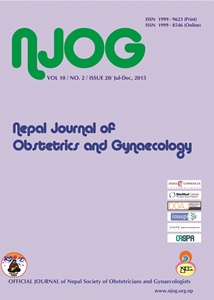Unsafe Abortion: Changing Pattern of an Avoidable Tragedy
Keywords:
maternal morbidity, maternal mortality, unsafe abortion.Abstract
Aims: The study was done to analyze current trend of unsafe abortion.
Methods: It was a prospective study where all the abortion related admissions from January 2009 to December 2011, in Obstetrics and Gynaecology unit at B.P. Koirala Institute of Health Sciences were analyzed. Sixty-six women with diagnosis of unsafe abortion were enrolled in the study. Cases of unsafe abortion were identified and classified using the classification developed by The South African National Incomplete Abortion Study conducted in 1994. Morbidity pattern was compared among the patients using the above classification system.
Results: There were 66 cases of unsafe abortion admitted in three years. Most common mode of unsafe abortion was by taking different types of oral drugs in various doses prescribed by medical shops, in 65.2% of women. Most common clinical presentation was heavy vaginal bleeding in 77% of women. After evaluation, commonest diagnosis made was incomplete abortion in 56.1% of women. In 57.6% of women, unsafe abortion was of low grade. In previous similar study done at the same centre, 16 (22.8%) of unsafe abortions were of low grade, 17 (24.2%) were of moderate grade and 37 (52.8%) were of high grade.
Conclusions: Unsafe abortion is still a significant medical and social problem. The mode of unsafe abortion, presentation and morbidity has changed significantly in recent years. However the morbidity pattern of unsafe abortion is going towards low grade.
Downloads
Downloads
Published
How to Cite
Issue
Section
License
Copyright on any research article in the Nepal Journal of Obstetrics and Gynaecology is retained by the author(s).
The authors grant the Nepal Journal of Obstetrics and Gynaecology a license to publish the article and identify itself as the original publisher.
Articles in the Nepal Journal of Obstetrics and Gynaecology are Open Access articles published under the Creative Commons CC BY-NC License (https://creativecommons.org/licenses/by-nc/4.0/)
This license permits use, distribution and reproduction in any medium, provided the original work is properly cited, and it is not used for commercial purposes.



